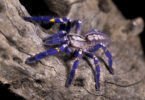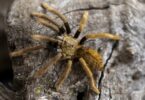Introducing, Megaphobema robustum - commonly known as the Colombian Giant Redleg Tarantula!
Are you looking for tips on how to successfully care and handle this beautiful spider? This blog will dive into everything related: from temperature/humidity needs to enclosure setup and substrate requirements.
Learn more about housing, growth rate, venom levels, food consumption patterns plus plenty more helpful insight regarding these unique arachnids.
Megaphobema robustum
This species of tarantula is native to Colombia, where it inhabits tropical forests with temperature and humidity levels that are specific to its needs.
The Megaphobema robustum is the scientific name for a species of tarantula commonly known as the Colombian Giant Redleg. This magnificent and vibrant arachnid originates form Colombia, where it can be found mostly in the tropics and sub-tropical regions which consist of warm climates with high humidity levels.
These spiders grow as juveniles into midsize adults within four or five years depending on their environment; they reach 7-8 inches leg spread when fully grown and possess beautiful coloring – mainly black legs with red hues reaching even brighter shades during moltings adding contrast to its unique characteristics making this spider striking.
Habitat and Climate
Megaphobema robustum can be found in the tropical rainforests of Colombia, with an average yearly rainfall of 2,500mm. The Colombian Giant Redleg, as it is also known, naturally inhabits Bogotá in Colombia. The average annual temperatures range between 23°C to 28°C (73.4°F to 82.4°F) with higher peaks in humid conditions, so providing similar settings for these spiders should prove proficient when keeping them as pets.
Care and Enclosure
An understanding of the environment and specification of its proper enclosure is essential when housing Megaphobema robustum, as their continued health depends on it. Read more to learn about the nuances of caring for this giant tarantula species.
Enclosure and Substrate
It is important to provide Megaphobema robustum with a suitable terrestrial enclosure and substrate. The ideal enclosure should be no less than two times the spider’s diagonal leg span in one dimension, providing plenty of room for them to move around comfortably.
This species prefers an environment complete with a retreat or hide that they can burrow into when feeling threatened or just looking for some additional security. A combination of peat moss, vermiculite, coconut fiber, and dirt should make up the substrate while maintaining four inches depth for firmness.
Humidity and Temperature
When it comes to the Megaphobema robustum, there are particular temperature and humidity levels that are necessary in order for the species to thrive. These spiders originate from Colombia, where dry weather usually prevails on the slopes of its Cordillera Oriental mountain range.
Thus, they prefer cooler temperatures ranging between 75°F - 84°F and high humidities between 70% - 80%. Keeping their enclosure within these parameters can be tricky because too much water may cause health issues. Substrate should be slightly moist but not overly wet as this could lead to respiratory problems and excessive mite development.
In my opinion, an ideal solution would be to lower the humidity to around 60-70%, but this is associated with more frequent misting or monitoring the water level in an additional dish.
Feeding
As juveniles and spiderlings, they’re fed 1/8” baby roaches about twice weekly; sub-adults eat adult B. dubia roaches or adult crickets every week while older spiders can eat less frequently with adults consuming prey only every 10 - 14 days or more as needed.
It is important to choose appropriately sized meals for your M. robustum tarantula — given their size difference between young and old it would be easy to give too large insects that could cause injury or scary our arachnid! Maintaining proper hides along with adequate humidity and temperature are essential components to feed these beauties.
Growth rate and Adult size
Megaphobema robustum is known for its medium-fast growth rate. With proper heating and feeding, the spider can grow up to three inches in a year of leg length. Full grown female, can reach even 3 inches in body length and 18 -20 cm in leg span. Males mature faster and are of similar size, but significantly slimmer.
This size is much larger than most tarantulas available in the hobby, making it impressive to observe once mature.
Temperament and Venom
The Colombian Giant Redleg, has a generally calm temperament and bites rarely cause major effects on humans. However, when provoked enough to bite or even threatened, the venom can inflict mild pain and swelling that lasts for a couple of hours.
While they are still juveniles up to five inches in size M. robustum will be shy because they have not yet fully matured into an adult temperment. As these spiders reach maturity their behavior changes and they become more confident while also becoming less prone to skittishness when alarmed or surprised by sudden movements.
Although their venom isn’t as potent compared with other species, it’s important for potential owners to note that these spiders possess urticating hairs, which, in certain cases, can pose a greater risk than a bite.
Conclusion
Colombian Giant Redleg Tarantula, is an impressive species of tarantula suitable for those with basic knowledge in arachnid care. This species originates from the tropical rainforest regions of Colombia and typically reaches a span of 6 to 8 inches when fully grown.
Megaphobema robustum is well-suited to life in captivity due to its hardiness and tolerate disposition, like most New World terrestrial tarantulas.
They make good display specimens because they are skittish but unaggressive towards humans, often choosing hiding rather than confrontation. This unique behavior combined with their attractive black/burgundy colouration makes this species an alluring choice among fanatics of tarantula keeping – inarguably one that should not be passed up on!
FAQs
1. How long does Megaphobema robustum live?
Megaphobema robustum has an average lifespan of approximately up to 15 years in captivity.
2. How do I care for Megaphobema robustum?
In terms of care, it requires consistent temperature between 24-26°C (76-80°F) and plenty of humidity with comfortable substrate to burrow into and create its habitat within you home or collection space.
3. How to breed Megaphobema robustum?
Mating itself is not problematic, although females in captivity tend to create an egg sac relatively infrequently. In the event of a successful mating and incubation, the sac may contain up to 100 eggs.






